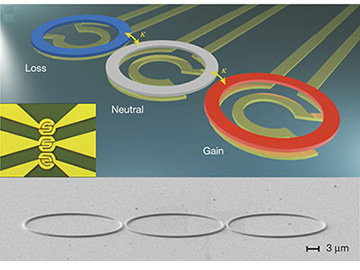![]()
In the work from the Yang lab in St. Louis, two light scatterers, represented by the blue spheres in this artist’s conception, are used to tune the sensors to exceptional points, at which light propagates in one direction. [Image: W. Chen and L. Yang, Washington University in St. Louis]
Like the classic movie scene of a sheriff breaking up a fight between two bar patrons, adding a third nanoparticle to an optical microcavity already containing two tiny light scatterers can perturb the system into a state of exceptional sensitivity. That tendency, according to a research team at Washington University in St. Louis, USA, could form the foundation for a system to detect nanoscale objects (Nature, doi: 10.1038/nature23281). And a separate study from researchers at the University of Central Florida’s College of Optics & Photonics (CREOL), USA, suggests that accessing higher-order versions of these special states could lead to detectors of even greater sensitivity (Nature, doi: 10.1038/nature23280).
Leveraging exceptional points
OSA Fellow Lan Yang and her colleagues at Washington University and at Otto-von-Guericke University, Germany, studied the so-called exceptional points—the “sweet spots” where strange behavior occurs—inside whispering-gallery microcavities. Physicists started exploring the occasionally counterintuitive physics behind these exceptional points in non-Hermitian systems, in which power is not conserved, around the start of this century.
Yang’s team constructed a tiny toroid containing two silica “nano-tips” of optical fiber, which acted as tiny Rayleigh scatterers of the light traveling in clockwise and counterclockwise directions, and used the tips to tune the system into having so-called second-order exceptional points. The cavity was doped with erbium to enhance the optical gain. The scientists then added a third scatterer, which perturbed the system, causing a slight but observable shift in its resonant frequencies.
Because the exceptional points are second order, the frequency shift in the group’s proof-of-concept sensor scales with the square root of the strength of the perturbation. In conventional optical-resonator sensors, by contrast, that frequency shift is directly proportional to the strength of the perturbation. Thus, for tiny perturbations, the sensors using exceptional points are more sensitive than conventional devices.
A higher-order scheme

The CREOL team’s setup used three coupled ring resonators, atop gold heating elements, to create a third-order exceptional point. [Image: University of Central Florida]
In a separate study, researchers led by OSA Life Member Mercedeh Khajavikhan and OSA Fellow Demetrios Christodoulides at CREOL, along with colleagues from CREOL and Michigan Technological University, USA, looked for a way to increase sensitivities still further by putting higher-order exceptional points to work.
To do so, the team fashioned a device consisting of three coupled, InGaAs ring resonators, each planted atop a 150-nm-thick gold platform that served as a micro-heating element. They then pumped the system with 1064-nm light, dynamically shaping the beam and tweaking the micro-heaters until the resonator on one side experienced gain, the one on the other experienced loss, and the one at the center was neutral.
Mathematically, when the gain-loss contrast in the system reaches a critical point, the system should be thrown into a third-order exceptional point. To test that out, the team simulated sensor perturbations by making tiny adjustments to the microheaters, and found that the frequency shift scaled as the cube root of the perturbation. That’s an indication that the system did indeed attain a third-order exceptional point—and also of the enhanced sensitivity that higher-order exceptional points can bring to the table.
Toward better sensors?
Whether second order or third order, much work remains to be done before these exceptional-point sensors can be practical. For example, creating the exceptional points in the first place requires careful tuning of the microcavity system.
Nevertheless, both teams argue that highly sensitive sensors involving exceptional points could someday detect many phenomena, from tiny mechanical vibrations in photonic systems to the presence of unwanted viruses in biological materials. The Washington University–led study concludes that the topological features of exceptional points could open opportunities not only in nanoparticle sensing but “in many other fields, including precision measurement, quantum metrology and non-reciprocal wave propagation.” And the CREOL-led group suggests that its results “may pave the way towards a new class of on-chip ultrasensitive sensing system.”
[Updated on 30 August 2017, to include the work of the CREOL-led group.]
Stewart Wills contributed to the reporting for this story.
